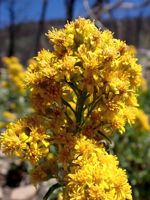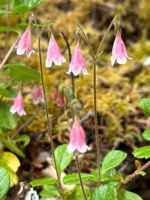Mon-Fri 9am - 5pm Mountain time
Missouri Goldenrod vs Twinflower
Solidago missouriensis
Linnaea borealis
NOT AVAILABLE THIS SEASON - MIGHT RETURN
CUSTOM GROW
Missouri Goldenrod is a native perennial wildflower known for its brilliant golden yellow flowers that bloom from late summer to early fall. The flower heads contain hundreds of tiny blossoms that attract a wide variety of pollinators, including bees, butterflies, and other beneficial insects. Fully opened flowers can also be used to make tea. As the season progresses, the flowers give way to fluffy seed heads, providing food for birds.
It can spread readily through its roots and self-seeding, this make Missouri Goldenrod well suited for hard-to-grow areas. This vigorous growth habit makes it an excellent choice for large planting areas, wildflower gardens, naturalized projects, prairie restoration, and erosion control.
Twinflower is a native, trailing evergreen ground cover known for its delicate flowers that grow in nodding pairs. These pale pink blooms are described as being sweetly fragrant, attracting native bees and other pollinators.
Growing in cool, moist, acidic soils, the trailing stems form roots as they spread and start to form mats across the forest floor. Due to its woody stem, it is technically classified as a shrub and often referred to as a subshrub or dwarf shrub. This species is well-suited for naturalization, restoration, and conservation projects.
Twinflower (Linneae borealis) was named in honour of Carl Linnaeus, who adopted it as his personal emblem.

